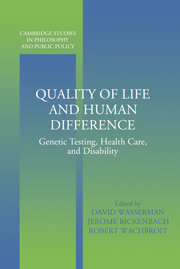Book contents
- Frontmatter
- Contents
- Contributors
- Acknowledgments
- Introduction
- 1 Assessing Quality of Life: Clinical versus Health Policy Uses
- 2 Predicting Genetic Disability while Commodifying Health
- 3 Preventing Genetically Transmitted Disabilities while Respecting Persons with Disabilities
- 4 Disability, Ideology, and Quality of Life: A Bias in Biomedical Ethics
- 5 Values for Health States in QALYs and DALYs: Desirability versus Well-Being and Worth
- 6 Preventing the Existence of People with Disabilities
- 7 Where Is the Sin in Synecdoche? Prenatal Testing and the Parent-Child Relationship
- 8 The Social Context of Individual Choice
- 9 Disability and Health Systems Assessment
- Index
7 - Where Is the Sin in Synecdoche? Prenatal Testing and the Parent-Child Relationship
Published online by Cambridge University Press: 03 December 2009
- Frontmatter
- Contents
- Contributors
- Acknowledgments
- Introduction
- 1 Assessing Quality of Life: Clinical versus Health Policy Uses
- 2 Predicting Genetic Disability while Commodifying Health
- 3 Preventing Genetically Transmitted Disabilities while Respecting Persons with Disabilities
- 4 Disability, Ideology, and Quality of Life: A Bias in Biomedical Ethics
- 5 Values for Health States in QALYs and DALYs: Desirability versus Well-Being and Worth
- 6 Preventing the Existence of People with Disabilities
- 7 Where Is the Sin in Synecdoche? Prenatal Testing and the Parent-Child Relationship
- 8 The Social Context of Individual Choice
- 9 Disability and Health Systems Assessment
- Index
Summary
The principal targets of what has become known as the disability critique of prenatal testing (PNT) have been health professionals and the policies they establish, not individual parents and the decisions they make. Indeed, one of the strongest complaints about professional practices and policies is that they infringe upon rather than enhance the reproductive freedom of individual parents, by pressuring them to abort fetuses that are likely to develop substantial impairments (e.g., Clarke, 1991; Wachbroit and Wasserman, 1995; Shakespeare, Chapter 8, this volume). Moreover, the “expressivist” objection to prenatal testing – that it reflects or embodies a conviction that children with impairments are a burden to themselves, their parents, and society – is more appropriately directed to the practices and policies adopted by professional groups than to the often confused and ambivalent decisions made by individuals in the face of those practices and policies.
Nevertheless, we believe that it is critical to examine the attitudes and beliefs with which individuals respond to the testing technology that is offered to them, however coercively. To some extent, that technology is made available in the belief that it serves the preferences and values of those who employ it. If the routinization of prenatal testing is in part an attempt to introduce eugenic policies through the “back door” (Duster, 1990), it is also in part a response to perceived consumer demand.
- Type
- Chapter
- Information
- Quality of Life and Human DifferenceGenetic Testing, Health Care, and Disability, pp. 172 - 216Publisher: Cambridge University PressPrint publication year: 2005
- 48
- Cited by

